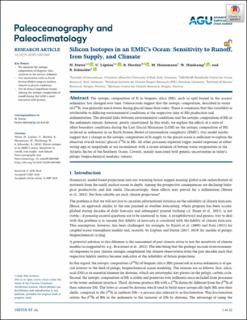Silicon isotopes in an EMIC's ocean: Sensitivity to runoff, iron supply, and climate
Dietze, Heiner; Löptien, Ulrike; Hordoir, Robinson; Heinemann, Malte; Huiskamp, Willem; Schneider, Birgit
Peer reviewed, Journal article
Published version
Permanent lenke
https://hdl.handle.net/11250/2689548Utgivelsesdato
2020Metadata
Vis full innførselSamlinger
- Articles [3012]
- Publikasjoner fra CRIStin [3070]
Originalversjon
Paleoceanography and Paleoclimatology. 2020, 35:e2020PA003960 (10), 1-22. 10.1029/2020PA003960Sammendrag
The isotopic composition of Si in biogenic silica (BSi), such as opal buried in the oceans' sediments, has changed over time. Paleorecords suggest that the isotopic composition, described in terms of δ30Si, was generally much lower during glacial times than today. There is consensus that this variability is attributable to differing environmental conditions at the respective time of BSi production and sedimentation. The detailed links between environmental conditions and the isotopic composition of BSi in the sediments remain, however, poorly constrained. In this study, we explore the effects of a suite of offset boundary conditions during the Last Glacial Maximum (LGM) on the isotopic composition of BSi archived in sediments in an Earth System Model of intermediate complexity (EMIC). Our model results suggest that a change in the isotopic composition of Si supply to the glacial ocean is sufficient to explain the observed overall low(er) glacial δ30Si in BSi. All other processes explored trigger model responses of either wrong sign or magnitude or are inconsistent with a recent estimate of bottom water oxygenation in the Atlantic Sector of the Southern Ocean. Caveats, mainly associated with generic uncertainties in today's pelagic biogeochemical modules, remain.
